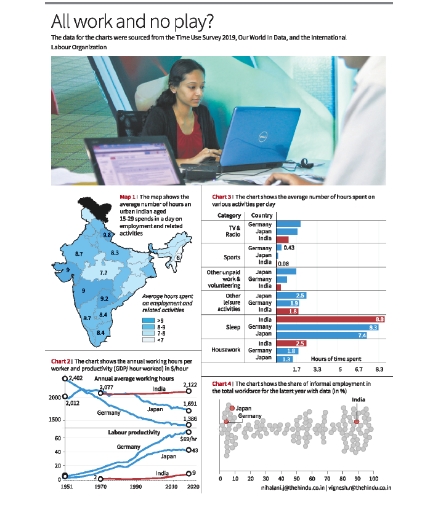Narayan Murthy : Putting the dea of the “70-hours workweek
Working harder does not necessarily lead to higher productivity.
- Infosys founder N.R. Narayana Murthy recently said that young Indians should work 70 hours a week. The comment received support from some and criticism from others. He said this in the first episode of the video series published by 3one4 Capital entitled “The Record”.
- Assuming a six-day work week, Murthy’s comments mean Indians would have to work 11.5 hours a day. How many hours does an average Indian youth work today? According to the India Time Use Survey 2019, a person aged 15-29 years spends more than 7.2 hours a day on work and related activities in rural areas and 8.5 hours a day in urban areas. A state-level comparison of time spent working in urban areas, indicating that the number is higher in rural areas, is shown in Map 1. Urban Uttarakhand comes out on top, with the state’s youth working an average of 9.6 hours per day. Which is about two hours less than Mr. Murthy had expected.
Assuming that if people worked 5 days, they would have to work 14 hours a day, one point to consider is whether working longer hours would lead to increased productivity. Mr. Murthy raised this point in a series of videos. “India’s labor productivity is among the lowest in the world. Unless we improve our labor productivity, we will not be able to compete with countries that have made tremendous progress,” he said. To emphasize this point, he cited the examples of Germany and Japan. “You know, that’s exactly what the Germans and Japanese did after World War II… It guarantees that every German must work overtime for a certain number of years.
Chart 2 shows a comparison of annual hours worked per worker and labor productivity in India, Germany, and Japan. The graph shows the average annual working hours per worker for Germans and Japanese. Japan reached its peak after the war, at between 2,200 and 2,400 hours a day. year. – About 8.3-9 hours per day in a five-day work week with no days off. This is still two and a half hours less than Mr. Murthy had expected.
More importantly, as labor productivity increased in Germany and Japan, two countries that were relatively more industrialized even before World War II, the average number of hours worked fell dramatically to about 1,400.1,600 hours per year in 2020 (from 5.3 to 6 hours per day). ) day). As shown in Chart 2. Labor productivity is measured in GDP per hour worked. Average annual working hours in India remained above 2,000 hours from 1970 to 2020, while labor productivity increased slightly from $2 per hour to $9 over the same period. So the question is: Is it better to increase working hours or increase productivity through technology? This is because longer working hours mean less time for exercise and entertainment. As shown in Chart 3, compared to Germany and Japan, Indians spend less time on sports and other leisure activities. Indians spend more time sleeping and doing household chores than the other two countries.
While there are differing opinions on Murthy’s proposal, it is worth asking whether India has sufficient statistical tools to accurately measure labor productivity, when 89% of the workforce is actively engaged in informal work compared to only 4.2% in Germany and about 4.2%. % In Germany. . 8% in Japan (Chart 4). In light of these vast differences in the nature of the workforce between the three countries, is this a viable comparison?
For more information visit at https://happenrecently.com/zepto/?amp=1
Source: www.thehindu.com



